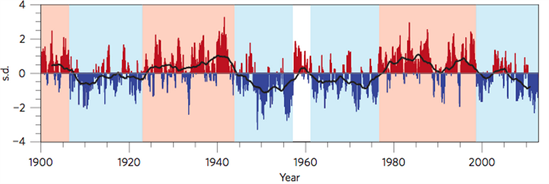Roz Pidcock
17.08.2014 | 8:20pmIf you follow climate science, you’ll be familiar with the so-called warming “hiatus”. It’s the fact that temperatures at earth’s surface haven’t climbed as much as expected in the last 15 years.
Now a new paper published in Nature Climate Change says the slowdown in surface warming could be behind a spell of colder than average winters in the UK recently.
UK winters in 2009/10 were two degrees and 1.3 degrees Celsius below the 1971-2010 long term average, respectively. The 2012/13 winter was 0.4 degrees below the 1981-2010 average. Source: Met Office
Cause of the pause
Scientists know greenhouse gases are driving up global temperature. But data on land and from the surface of the ocean shows slower than expected warming in the last 15 years or so.
Scientists say periods of slower and faster warming aren’t unusual. Most of why we’re seeing one now is down to natural climate cycles causing the surface of the Pacific Ocean to cool.
The trade winds in the Pacific have been unusually strong since about 2000, a study last year showed. And that’s driving more heat into the deep ocean, rather than staying at the surface.
So warming is continuing, but heat is being rearranged within the vast oceans.
Pacific connections
Scientists think the shift in the trade winds is being driven by a larger natural cycle, the Pacific Decadal Oscillation (PDO) cycling between its warm and cold phases.
A new paper by Professor Kevin Trenberth from the US National Center for Atmospheric Research and colleagues explains:
“The Pacific Decadal Oscillation was in a negative phase before 1976, but became positive from 1976 to 1998, a period coinciding with strong increases in global mean surface temperatures. Then it switched to a negative phase in 1999, coinciding with the pause in the upward trend in global mean surface temperatures.”
The positive (red) and negative (red) phases of the Pacific Decadal Oscillation (PDO). You can see the shift from positive to negative in 1999, leading to lower than average sea surface temperatures in the North Pacific. Source: Trenberth et al. ( 2014)
Though this happens all the way out in the Pacific, it has consequences across the world. The cooling pattern disturbs atmospheric circulations locally, which then propagate in a “wave-like” pattern from the Pacific right across polar regions and the Atlantic, the paper explains.
The cooling effect in the Pacific is particularly strong in winter, increasing the odds of cold winters as the wave train makes its way across Europe, say the authors.
What happens is the atmospheric waves emanating from the tropical Pacific trigger a shift to the negative phase of a second natural cycle, the North Atlantic Oscillation (NAO). The paper says:
“In turn, this favours cold outbreaks in Europe, as occurred in 2009-2010, 2010-2011 and 2012-2013.”
How about an Arctic link?
Scientists also have a theory about what could be behind recent cold winters in the UK.
Arctic sea ice is declining rapidly, with the seasonal low in summer shrinking particularly quickly . The loss of reflective sea ice is part of the reason Arctic temperature has risen three times faster than the global average in recent decades, an effect known as Arctic amplification.
As temperatures rise faster in the Arctic than at lower latitudes, it’s thought this alters atmospheric circulations, including the jet stream – a stream of fast-flowing air in the atmosphere.
The theory goes that as the jet stream slows down and meanders more, Arctic air reaches further south and sticks around for longer than usual, affecting the climate in places like Britain.
This Met Office video explains how the jet stream affects the weather we see in the UK.
A scientific dispute
This is a very new area of research. Another new paper just published in Nature Geoscience looks at the evidence for and against an Arctic connection with Northern Hemisphere weather.
It suggests that while the mechanism still isn’t clear, the evidence pointing towards a link is fairly compelling. By the end of the 1990s, the frequency of unusually cold winter months started to increase, coinciding with an acceleration in the rate of Arctic warming. And the paper says:
“The seven years between 2007 and 2013 have exhibited the lowest minimum sea ice extents recorded in September since satellite observations began â?¦ Several of these seven winters following the low sea ice minima have been unusually cold across the Northern Hemisphere”.
But there is still lots of uncertainty about whether or not Arctic amplification can affect mid-latitude weather so directly, the paper adds. Not least of which is a lack of data in the Arctic.
Other studies have disputed a link too, says the Trenberth paper. The authors suggest an alternative theory, that a warmer Arctic is a consequence of a wavy atmosphere, not the cause.
The reason could be increased exchanges of cold air from the Arctic with warmer air from lower latitudes, all a consequence of the cooling in the tropical Pacific, the authors explain.
A return to form
If the ‘hiatus’ in surface warming is largely down to natural variability, we should expect a return to faster warming at some point in the not too distant future. But while it’s here to stay, the chances of a colder winter in the UK may have just climbed a little higher.
Sources:
Trenberth, K. E. et al., (2014) Seasonal aspects of the recent pause in surface warming. Nature Climate Change doi:10.1038/nclimate2341
Cohen, J. et al., (2014) Recent Arctic amplification and extreme mid-latitude weather. Nature Geoscience doi:10.1038/ngeo2234
Huber, M. & Knutti, R. (2014) Natural variability, radiative forcing and climate response in the recent hiatus reconciled. Nature Geoscience doi:10.1038/ngeo2228



